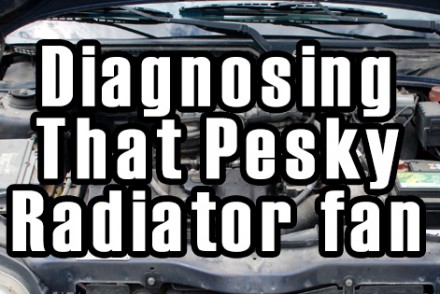The possible causes of engine overheating are many and varied, but if the overheating is not serious, or occurs sporadically, and the vehicle is still drivable, it is often possible to locate and fix the root cause yourself. Phew!
All engine cooling systems work the same way, and most use the same components, which means that despite some minor design differences, fault-finding and repair procedures are much the same on all vehicles.
So if you are experiencing overheating problems on your vehicle, here is how to locate, and fix the problem.
Video: How To Fix An Overheating Car
In the video above, Scotty Kilmer, a Youtuber with an extremely helpful car repair/maintenance channel, goes over the most common problems of an overheating car.
The video is short and to the point. If you’re facing the frustrating situation of an overheating car, it would be a smart idea to pay attention to that video.
Time required to fix an overheating car.
The time required largely depends on the nature of the problem.
Some cures can take only a few minutes while others can take several days, depending on parts availability and other factors.
Is it difficult to fix an overheating car?
Again, this depends on the nature of the problem as much as it does on your skill level. To most people, fixing a coolant leak might be a simple matter, but to others it could be an insurmountable problem.
However, repairs that involve removal of the cylinder head(s) or even the entire engine for rebuilding or replacement can be challenging for DIY mechanics, which is why we recommend that this type of procedure be left to professional mechanics and repair shops that have the required equipment.
Special precautions to take when fixing an overheating car.
It is important to note that some diagnostic tests and checks can only be performed when the engine is hot.
It is therefore important to be extra cautious to avoid burns and scalds, but also not to wear loose clothing that can be entangled in moving parts like drive belts and fans.
Equipment required to fix an overheating car:
- Repair manual, or instructions that pertain to your car that is available online.
- Compression tester.
- Digital multimeter.
- Cooling system leak-down kit.
- Torque wrench.
- 3/8-inch drive socket set.
- ½-inch drive socket set.
- Set of combination wrenches.
- 8” pliers (to remove radiator hose clamps.)
- Small/medium Phillips and flat-bladed screwdrivers.
- RTV silicone (or similar gasket sealant.)
- Anti-freeze (to replace lost anti-freeze in the coolant.)
- Replacement hose clamps (of the correct size.)
As a rule, the above list will enable you to repair most issues that cause engine overheating, but depending on the exact cause you may need additional items, or not everything on this list.
NOTE: Due to the high number of possible causes of overheating, it is not possible to supply a complete parts list for this repair.
However, typical replacement parts can include radiators, radiator hoses, water pumps, cooling fans, thermostats, temperature sensors, fan control switches/modules, and cylinder head gaskets.
Also, note that serious overheating can cause severe degradation of the engine oil, so you may need to replace the oil and oil filter as well.

Engine overheating fix #1: Find and repair coolant leaks.
The first step in the diagnostic procedure is to find the exact cause of the problem.
As a start, you need to check the engine for visible signs of coolant leaks, and to repair them as required.
However, you may need to remove some engine components to repair some leaks, so consult the manual on the correct procedure.
You may need to remove the radiator to inspect it for leaks if you do not have access to a cooling system leak-down kit.
Alternatively, you can take the radiator to a specialist shop to perform a pressure test for you. If the damage to the radiator is not too severe, a competent radiator shop will be able to repair the leak(s) reliably.

Engine overheating fix #2: Check the appearance of the coolant.
The next step involves checking the both the level, and the appearance of the coolant, but make sure the engine is cold before you remove the radiator cap to avoid serious personal injury.
If the coolant is clear, take a good sniff of the coolant- if it smells like exhaust gas, some combustion products are leaking into the coolant system via a leak path in the head gasket(s).
The only reliable remedy for this is replacement of the head gasket, and a thorough examination of the cylinder head(s) for cracks.
This examination is best left to professional engine rebuilders, since they have the required equipment to examine, and possibly repair the cylinder head(s) properly.
NOTE: If you have any doubts about you ability to remove and refit cylinder heads, do not attempt it. Seek professional assistance to avoid causing even more damage.
Engine overheating fix #3: Check for the presence of oil in the coolant.
In some cases of cylinder head gasket failure, or a fracture in the cylinder head, the engine oil and coolant may come into contact with each other.
If this happened in your case, there will be evidence of oil in the radiator, or there will be a milky-white substance in the radiator.
This substance is an emulsion of the oil/coolant, but it may not be present in all cases of gasket or cylinder head failure, and subsequent engine overheating. Nor will the coolant always smell like exhaust gas, so the next step involves performing a compression test on all cylinders.
Engine overheating fix #4: Check compression on all cylinders.
A serious loss of compression on one or more cylinders will always cause a severe misfire, but it may not necessarily lead to engine overheating.
However, small leaks past the head gasket(s) may place the coolant system under severe pressure, which will cause overheating, but not necessarily a noticeable misfire, except perhaps when starting the engine.
Thus, if the previous checks did not reveal the cause of the overheating, a compression test will help to either confirm, or eliminate a failed head gasket as the cause.
Note however, that the results of a compression test depend largely on how the test is performed, so consult the manual on the correct procedure, and follow all the steps exactly.
Here is what to look out for during a compression test:
- All readings should be within a few percentage points of each other for all cylinders.
- A low reading on one cylinder will not necessarily cause overheating, but it might, depending on the site of the leak path in the gasket. Bear in mind though that a low compression reading on one cylinder may not be related to a failed gasket- there are many other possible mechanical causes for a low reading on one cylinder.
- Two adjacent cylinders that show low readings is almost always the result of a failed head gasket, but this does not always cause overheating. If the leak path in the gasket does not lead to the water jacket (cooling system), the engine will not necessarily overheat. There will however be a severe misfire, and depending the degree of compression loss, it might not be possible to start the engine.
- In all cases where there is oil in the coolant, coolant in the oil, or the coolant smells like exhaust gas in combination with low compression readings, the cause of the overheating is a failed head gasket. The remedy is replacement of the head gasket, and an examination of the cylinder head.

Engine overheating fix #5: Check the cooling fan operation.
A common cause of engine overheating is cooling fan failure; however, there are many possible reasons why a cooling could stop working, and not all failures will necessarily trigger a warning light.
The first time a warning light may come on is when the engine has already overheated, so for this test, you need to consult the manual to locate all the switches, sensors, relays, and control modules that control the cooling fan.
In many cases, the problem can be corrected by replacing a fuse, relay, or control module, but you need to follow the testing procedures in the manual exactly to avoid damaging something else.
Nonetheless, fuses and relay are usually clearly marked or identified, and replacing them should not present any major stumbling blocks.
WARNING: Some electrically operated cooling fans cannot be tested by applying power to them directly from the battery.
Doing this can damage the electrical system on some cars, so refer to the manual on the correct procedure to test the fan for correct operation.
NOTE: Testing electrical circuits can be very challenging, even for experienced mechanics, so if you have any doubts on your ability to trace and correct electrical issues, do not attempt to do so.
Seek professional diagnosis and repair to avoid causing extensive damage to the electrical system if you accidentally cause a short-circuit.
If the electrical control system of the fan checks out OK, the problem could involve the circulation of the coolant, so you need to check this next.
Engine overheating fix #6: Check coolant circulation.
WARNING: This check requires that the engine be hot, so exercise extreme care to avoid sustaining serious burns and scalds against hot engine components.
If all the other checks turned out negative, the most likely other cause of the overheating is a failed thermostat. Thermostats can fail without warning, and for no apparent reason, and there is nothing any driver can do to prevent it happening.
In its simplest form, a thermostat is valve that is located close to the engine, and it reacts to the coolant temperature to either open to allow the coolant to circulate through the system, or to close to inhibit circulation to allow the coolant to absorb heat from the engine.
If the thermostat functions correctly, it will control and maintain the coolant temperature to within a few degrees, but when it fails, it can (and does) cause fatal overheating in a matter of seconds. Here is how to check its operation:
- Close the radiator cap, and start the engine, but make sure you can reach both the top and bottom radiator hoses. Remove any protective shields and covers that are in the way.
- Allow the engine to run at idle, while monitoring the temperature gauge. Do not allow the indicator needle to rise to above normal.
- Bear in mind that if the thermostat is indeed defective, the cooling fan may not engage as soon as the engine reaches operating temperature. The fan is controlled mainly by the coolant temperature, and most heat sensing sensors are located between the thermostat and the fan control switch, which means that the fan will not receive a signal to switch on.
- When the temperature gauge reaches a point about halfway between “Cold” and “Normal”, touch both radiator hoses to gauge their temperature. It is not important how hot they are to the touch- if they have the same temperature at this point, it means that the thermostat is stuck in the open position. This means that the coolant is circulating too fast, and the engine will overheat because the coolant does not have sufficient residual time in the radiator to cool down.
- Keep monitoring the temperature of the hoses. As the engine heats up, only the temperature of the top hose will rise with it if the thermostat is stuck in the closed position. The bottom hose will remain cool, and if it remains cool when the temperature gauge reaches the “Normal” point, you can bank on the fact that the thermostat is defective.
The only reliable remedy is replacement of the thermostat, and preferably with an OEM part.
There is however no guarantee that even an OEM part will not fail at some point in the future, but an OEM part is less likely to fail than an aftermarket alternative.
Final Notes on Fixing an Overheating Car:
WARNING: Do NOT remove the thermostat while the engine is hot. Doing so could have the same effect as opening the radiator cap of hot engine, and serious injuries could result.
NOTE: Do not modify the defective thermostat in any way in attempts to make it work. There is no reliable way to repair a thermostat, and all attempts to do so could lead to severe engine overheating. Do the right thing, and replace it.
TIP: Be aware that some engines require that all air be purged from the cooling system when the system is filled. It is critically important that you follow the instructions in the manual on how to do this EXACTLY.
Failure to purge all air could lead to air locks that act as “valves” that can cut the coolant circulation off as effectively as a defective thermostat can.
Make sure to comment down below and share this article on social media if you enjoyed it!
Thank you for reading! We appreciate it very much.





No Comments